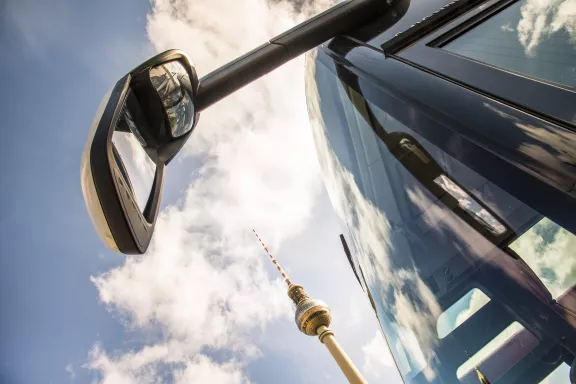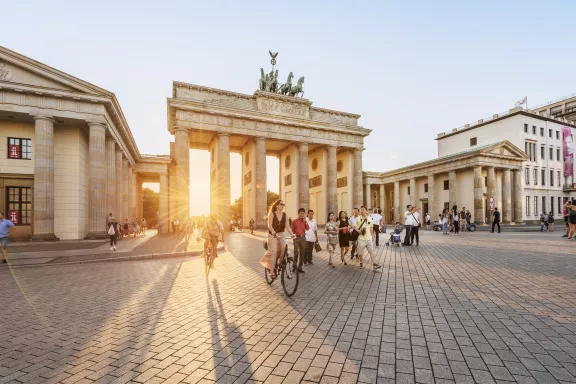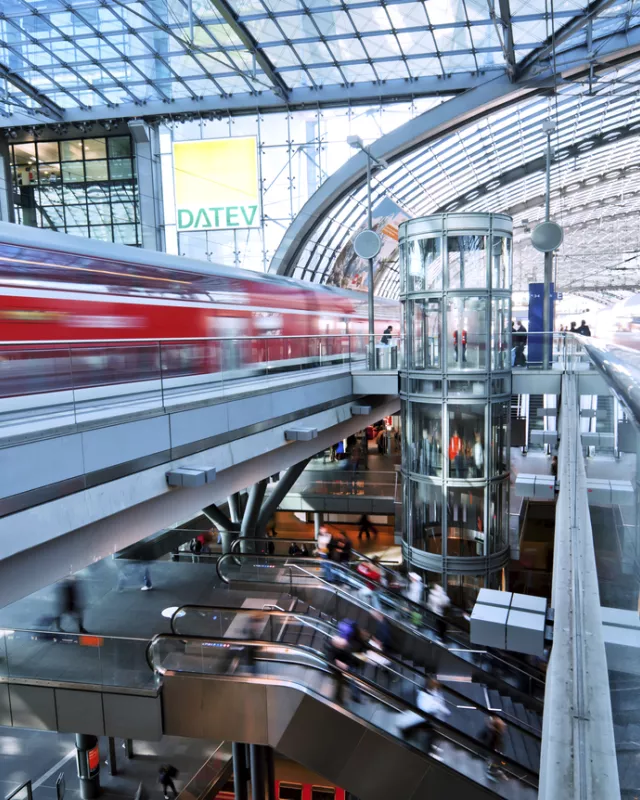Berlin connects
- Connectivity news: New Berlin-Paris rail link starts on 16 December
- Around 13 per cent more passengers at BER in the first half of 2024 than in the same period of the previous year
- How guests from all over the world can travel to the German capital. Travelling to and from Berlin is easier and more attractive than ever before

Berlin, October 2024 Berlin is a cosmopolitan city - and the whole world wants to come to Berlin. The German capital benefits from its location in the centre of Europe. And its growing connections to all major transport routes make it more than ever an important hub, regardless of the means of transport used for travelling. For example, Berlin and Paris will have a direct daily rail connection from December 2024. New and more frequent flight routes will make Berlin accessible from even more places, both in Europe and overseas. Thanks to the world's best S-Bahn and U-Bahn network with 16 lines, according to TimeOut, you can also travel quickly within the city - without traffic jams and in an environmentally friendly way. With the Berlin WelcomeCard, Berlin travellers can even use public transport throughout Berlin free of charge. What's more, it gives you discounts at over 200 attractions and sights. So all roads lead to Berlin - more than ever.
The railway is extending its lead
Berlin Central Station is the largest interchange station in Europe. It therefore plays a major role as a destination and hub. Important innovation in winter 2024: from 16 December 2024, there will be a new daily direct connection between Berlin and Paris. Travellers will then be able to travel from one capital to the other in around eight hours during the day without changing trains. Intermediate stops are Frankfurt am Main (South), Karlsruhe and Strasbourg. Until now, the only direct connection on this route was ÖBB's Nightjet three times a week.
More and more guests are using the train to visit the capital. In 2023/2024, 50 per cent of all visitors travelled to Berlin by train - an increase of six percentage points compared to 2022. The railway is generally recording strong growth in international travel: in 2023, a total of 24 million passengers travelled across borders by train - 21 per cent more than in 2019. Connections to Eastern Europe are also being intensified. The number of journeys to and from Warsaw was already increased to up to six journeys per day in summer 2023, and there are also a total of three transfer-free EC journeys per day and direction to and from Wrocław and Kraków. The Berlin-Wrocław culture train will also run until the end of December 2024. Since its launch in 2016, the journey itself has been an attraction with readings and music on board. It will continue in spring 2025.
Sustainability before speed
One important reason for the shift from air travel to rail travel is that the issue of sustainability is becoming increasingly important. Bahnhit Berlin, a provider of city breaks in partnership with Deutsche Bahn, surveyed 800 customers in 2022. 85 per cent of them stated that sustainability is important to them. And for 48 per cent of those surveyed, a journey time of up to ten hours by train is acceptable. Within Germany, some train journeys can take
Night trains

Travelling in your sleep - night trains are on the rise
Travelling by night train is becoming increasingly popular. Several companies literally connect numerous European metropolises with Berlin overnight. Depending on the provider and service selected, there are three, four or six berths in a compartment. Since May 2023, the overnight train operated by the Belgian-Dutch start-up European Sleeper has been travelling three times a week between Berlin via Amsterdam and Rotterdam to Brussels. From there, you can even reach London with just one change. In March 2024, the route was extended via Dresden to Prague. Austrian Federal Railways (ÖBB) has been connecting Berlin and Vienna or Paris with its Nightjet for some time now.
A new EU project with state and private railway companies has also been providing more night train services to Scandinavia since 2023. Sweden's state railway SJ has extended its existing route to Hamburg to Berlin from April to September. The Swedish company Snalltaget also connects Stockholm and Berlin with a night train via Denmark's capital Copenhagen. Eastern Europe and the Balkans are also connected to Berlin by night trains. The Hungarian state railway MAV offers the Euronight to Bratislava and Budapest in partnership with ÖBB. And the Czech company Regiojet operates a night train between Berlin and Ljubljana with stops in Zagreb, Maribor and Graz, among others.
Direct flights to the USA

New connections and more passengers at BER Airport
It's not just rail transport to and from Berlin that is growing strongly. There are also many interesting new flight connections at the capital's BER airport. For example, new direct connections to the US metropolises of New York (JFK) and Washington (Dulles) were launched in 2023.
But there are also numerous new destinations in all directions on this side of the pond. Lufthansa subsidiary Eurowings, for example, has increased its flight offering by 120,000 seats with the 2024 summer timetable. This was made possible by additional destinations and higher frequencies for connections that are already in high demand. The destinations Erbil (Iraq), Tivat (Montenegro) and Yerevan (Armenia) were added in the summer. Dubai (UAE) and Jeddah (Saudi Arabia) will follow with the winter flight schedule from the end of October 2024. And new direct flights to Vienna and Zurich come at just the right time. According to visitBerlin Managing Director Burkhard Kieker, a survey of 6,000 people in Switzerland, Austria and Germany at the beginning of 2024 revealed that Berlin is the capital city destination there. This put the German capital ahead of destinations such as Amsterdam and London.
As another major player at BER, EasyJet has expanded its capacity by 200,000 to four million seats with the 2024 summer flight schedule. Connections to Birmingham, Toulouse, Salerno, Izmir and Antalya have been added. Other routes will be served more frequently, for example to Basel, Zurich and Geneva in Switzerland, as well as to Copenhagen, Bordeaux, Paris, Nice and Rome.
In the first half of 2024, passenger numbers at BER recorded a positive trend: at 11.8 million passengers, the figure was 12.7 per cent higher than in the same period in 2023. BER is also expecting growth of around 12 per cent for 2024 as a whole compared to the previous year. Low-cost carriers account for over 60 per cent of the total number of seats.
With the 2024 summer flight schedule, a total of 148 destinations in 49 countries can be reached directly from BER with 68 airlines.
Bus

By bus to Berlin
Travelling to Berlin by coach is cheap and convenient. Several companies connect a large number of cities in Germany and abroad with the capital by coach. The Czech provider Regiojet, for example, not only offers night trains, but also coach journeys. A Regiojet bus runs regularly from the central bus station at the exhibition centre via Dresden to Prague. The Eurolines bus routes serve over 80 stops within Germany alone and connect over 700 cities in more than 30 countries. And you can also travel in all directions with the green Flixbus, from Gothenburg to Venice and from Brussels to Wroclaw.
Bicycle and more

Unbeatable in the city: the bicycle
For many people in Berlin, cycling is the mode of transport of choice. Traffic jams and searching for a parking space are not an issue and at the same time you are doing something good for the environment and your own health. So it's no wonder that bike couriers and bike taxis are always on the move in the city. And even if you don't own a bike or are just a guest in Berlin - you can find a bike practically anywhere and at any time. Numerous hire companies offer models for every need, from children's bikes to e-bikes, cargo bikes and tandems. You can book a bike even more spontaneously via one of the bike sharing providers. Simply use the app to display the location of an available bike, reserve the bike you want and you're ready to go. Car sharing is just as practical and convenient if you do need a car. Together with e-scooters and the attractive public transport system, mobility in Berlin really is available in every direction and in every situation.
Everything revolves around bikes here
The ADFC rally has a long tradition in Berlin. It took place for the first time in 1977, organised by a citizens' initiative. The General German Bicycle Club now organises the major event and invites young and old cycling enthusiasts to take part on 1 June 2025. A total of 20 routes of different lengths and from all directions in Berlin and the Brandenburg region will converge at the Großer Stern. In previous years, up to 30,000 participants have taken part in the event.
The ADFC's nationwide CITY CYCLING campaign is also practically an institution in Berlin. The aim is to collect as many kilometres by bike as possible during the campaign period, for example by switching from car to bike more consistently than ever before. The kilometres are counted conveniently and easily via GPS using the CITY CYCLING app. In 2024, a total of 2,886 municipalities took part. The Berlin team with 32,465 participants took first place, well ahead of the Hanover region and Munich. The date for 2025 has not yet been set - but Berlin will definitely be back on the pedals.
Cycling over land and across the sea
If you take a few days to do this, you will discover that cycling is not only good in the city. The Berlin-Hamburg long-distance cycle path runs for around 300 kilometres from Berlin to the ‘Gateway to the World’ on the Elbe. You can even cycle more than twice as far on the Berlin-Copenhagen cycle path. The German section leads from Berlin through Brandenburg and Mecklenburg-Western Pomerania to Rostock. From there, you can reach the Danish mainland in less than two hours by ferry to Gedser. Then continue by bike via Nykøbing and Greve Strand to the capital Copenhagen, which is famous as the ultimate cycling city. On around 650 kilometres of well-maintained and mostly flat cycle paths, you can experience sights, museums and lots of nature along the route in around eight days. Near the coast, the wind can sometimes slow you down a little. But you're probably in no hurry on this route. Here, the journey really is the reward.
More information about Berlin at visitBerlin.de.



